Q&A: Looking ahead to season two of ‘The Look Back’
PBS Wisconsin Education’s The Look Back is a series developed for students in grades 4-6, exploring Wisconsin’s historical eras through artifacts.
09/16/24
PBS Wisconsin Education’s The Look Back is a series developed for students in grades 4-6, exploring Wisconsin’s historical eras through artifacts.
09/16/24
PBS Wisconsin Education’s The Look Back is a series developed for students in grades 4-6, exploring Wisconsin’s historical eras through artifacts. Five Wisconsin historians model historical inquiry as they ask questions, gather evidence and share their findings in fun and unique ways.
“Our aim is to provide students and educators an engaging way to learn about Wisconsin history,” said PBS Wisconsin Education executive producer Ryan Hendricks. “It’s a fun and informative way to understand Wisconsin’s place throughout history.”
Season two of The Look Back kicked off with an episode on tall tale postcards from the early 1900s. The postcards depict larger-than-life produce and animals created with early photography tricks. Other artifacts this season will include a circus poster, Dungeons and Dragons booklets, and an airway beacon used for flight navigation.
PBS Wisconsin Education recently sat down with David Boffa, education producer, and Nick Hoffman, The Look Back co-host and Wisconsin Historical Society administrator of museums and historic sites, to hear about their experiences with the series.
PBS Wisconsin Education: New episodes of The Look Back have started rolling out. How is season two going so far?
Nick Hoffman: It’s going great. I think we’re really pushing the creativity this season. Part of that is being in new places to many of us who are traveling around the state, visiting different museums, historical societies and even random parks! I think that’s going to help us with our overall approach to how we’re engaging students.
David Boffa: We’re also incorporating more people into our writers’ room. Last year we didn’t even have a writers’ room. It was kind of one or two of us writing an episode, then working with the hosts to refine it, maybe on set or the day of shooting. This season, every episode we’re doing at least one writers’ room, if not multiple writers’ rooms, where we incorporate hosts’ ideas, maybe museum folks’ ideas, information from our accessibility advisor. So every episode has a lot of voices, and that makes it more fun.
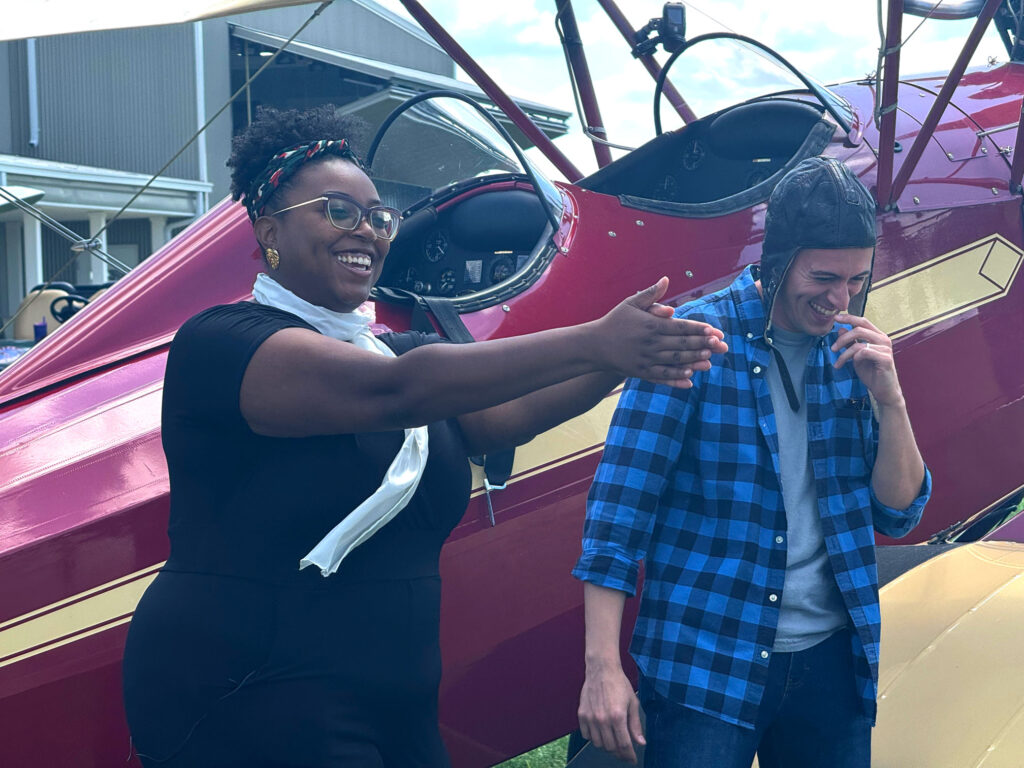
Co-hosts Taylor Bailey (left) and Sergio González film at the Kelch Aviation Museum in Brodhead, Wisconsin.
PBS Wisconsin Education: What is the writers’ room like?
Boffa: This is still new, so it might change as the season goes on, but ideally what happens is, I’ll share some research in advance, a little bit of information on the artifact or the topic. And then whoever can come to the writers’ room shows up. We have people in person as well as people attending virtually.
We’ll have one writer’s room where we basically just try to figure out the title and thumbnail for the episode. You’re competing against everybody else on the internet, so we spend a lot of time working on that title and thumbnail idea and trying to come out with a few closely related options that might work in the future.
In Circus World [Museum], for example, we could have gone in like 10 different directions. Ultimately in the writers’ room, we figured out we really want to focus on the workers. What was the experience like for the workers – for young children, for adults, for Black performers, for disabled performers?
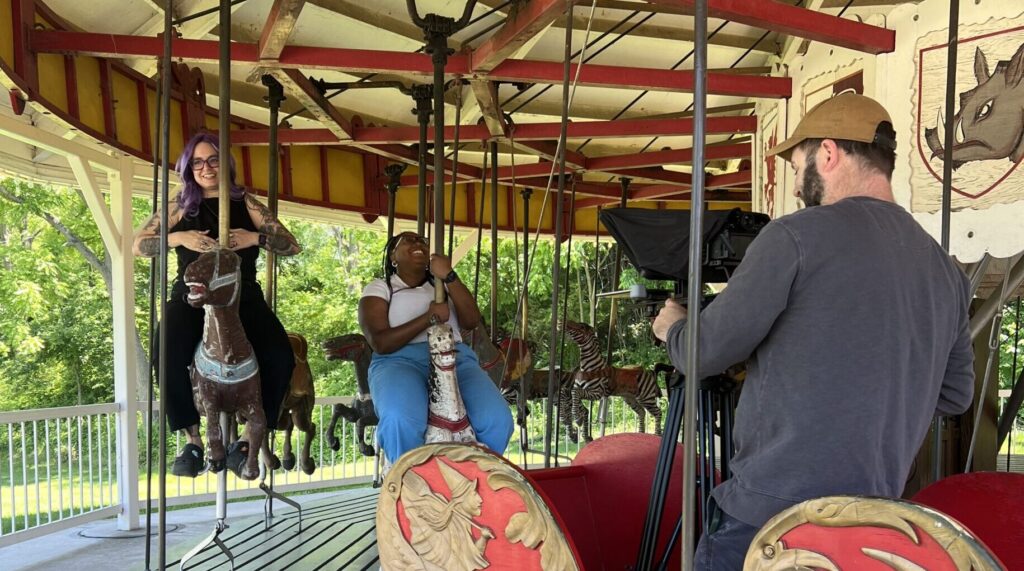
The Look Back co-hosts Kacie Lucchini Butcher (left) and Taylor Bailey (center) film with executive producer Ryan Hendricks on the carousel at Circus World Museum in Baraboo, Wisconsin.
We also try to figure out what’s the story, what’s the thread that’s going to carry us through the episode? We’ll build an outline, and then I’ll go and work on that outline and fill in the dialogue and the story beats and things like that, and then share it out. People can give feedback on that as well. At every step, there’s an opportunity for anyone who wants to provide input and feedback.
PBS Wisconsin Education: The Look Back is created with and for 4th through 6th grade educators and students, but the videos are really fun and entertaining for grown-ups, too. Why do you think the series appeals to such a broad audience?
Boffa: Nick, you’re on the other side of the camera making it fun.
Hoffman: I think it’s because people are naturally curious about the state’s history and their localities and how they connect to the past. I think our approach has made it pretty accessible to really anybody.
But, we’re also given really cool access to collections around the state. So it just has that right recipe for a program that has a lot of entry points for a lot of different people. And the idea of going subject by subject means people can browse. They can find what they’re really interested in and just jump right into that episode.
Boffa: The other thing I’d add is that we’re working with real historians who themselves are curious about these things, and seeing somebody enthusiastic and curious like that just makes you enthusiastic and curious. Like Nick in season one with the bike episode, he’s not faking it, right? He’s legitimately into bike history.
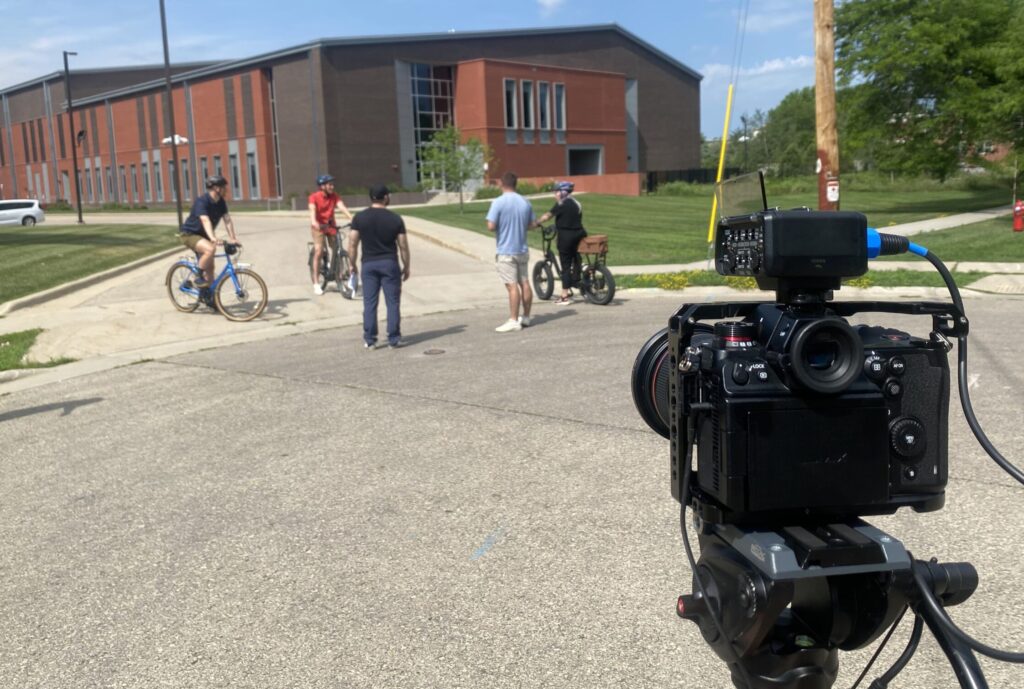
Production during season one at the State Archive Preservation Facility in Madison, Wisconsin.
Hoffman: Yeah, I intentionally picked episodes to go on where I knew I’d learn a lot – subject areas that maybe I haven’t read as much about. I learned just as much filming an episode as any of the students or other viewers might.
Before each episode, I’ll spend some time reading about whatever the subject matter is. So it was pretty easy working with Sergio around the migrant workers’ bunk bed because I could just go to his articles and read them! Just doing some really basic research and finding secondary sources helps me prep better probing questions before we go into filming. I try to do that for every episode.
And, of course, filming at the historic sites which I work with across the state, I’ve got a pretty good sense of the experience and what we might engage with there.
So the filming at the photography studio and museum was really natural because I’ve been through that process before. I’ve learned a lot from Dave Rambow, so it was easy for me to ask different questions I’ve been curious about in the past.
PBS Wisconsin Education: Is there any artifact you’re particularly excited about this season?
Boffa: The Dungeons and Dragons (D&D) artifact. It’ll be some of the original booklets from the mid-1970s that were made for the first editions of Dungeons and Dragons. I love all the artifacts, but I think those are a great reminder of how important play is.
It’s been happening for the past 10 or 20 years, certainly, but there is more acceptance now that play and games are areas of serious study and they’re important for development. They tell us a lot about people’s interactions and a lot about history. And we’re going to talk to somebody who’s going to share, for example, like, why Wisconsin? Why was D&D developed in Wisconsin, and why was it developed in Wisconsin in the mid-1970s?
D&D is very famous now, but also, according to people who study games, is a new type of game and there aren’t that many types of games. There are fewer than a dozen types of games. And, for some reason, in the mid-1970s in Wisconsin, an entirely new category of games was developed. In Lake Geneva, of all places!
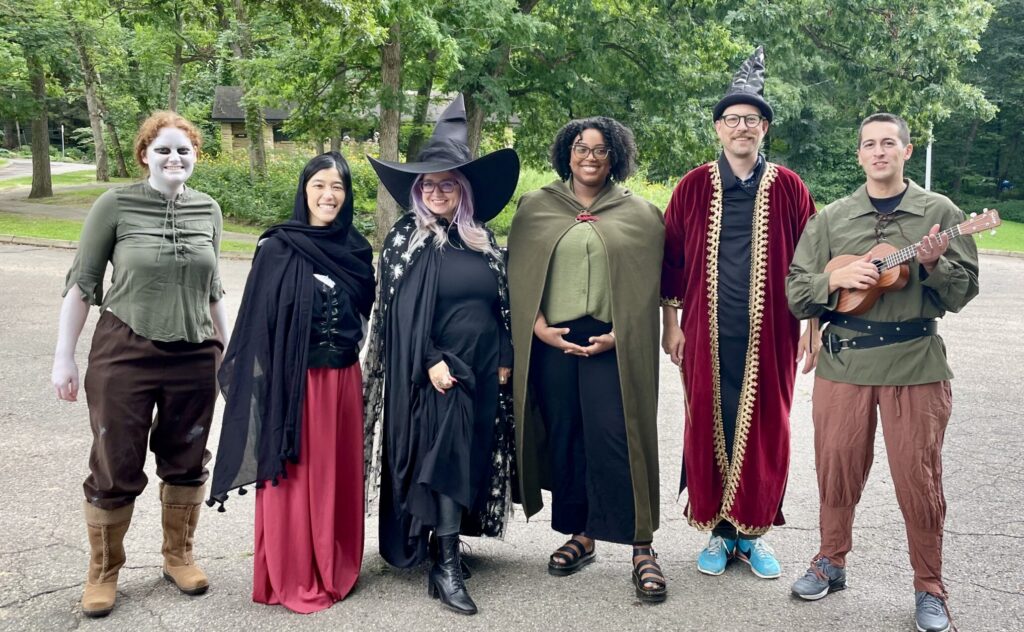
The Look Back crew getting into character for an upcoming episode on Dungeons and Dragons booklets. From left to right, Catie Pfeifer, PBS Wisconsin closed captioner, and co-hosts Cat Phan, Kacie Lucchini Butcher, Taylor Bailey, Nick Hoffman and Sergio González.
Hoffman: They’re all pretty great, but I’ll say the tall tale postcards. Mostly because in that episode we get to understand the actual process of photography. We’re contextualizing the cameras or the postcards in a lot of different ways, both to show you the sleight-of-hand tricks that were used to create the postcards, and the basic science of photography in the early 20th century.
PBS Wisconsin Education: What memorable experiences have you had filming this season so far?
Boffa: I think the filming for the Dungeons and Dragons artifact. We’ve done one day of filming so far, and it was with all of our hosts.
We told all our hosts before we started season one, there’d be no scripted content. They wouldn’t have to memorize any lines. And here we are, first day of filming this episode, and it’s all memorizing lines and acting! And they’re in costume and we’re outdoors on location.
All of us producers after that day, we’re like, we got through so many pages of script! We shot everything we wanted to shoot, which was amazing. We would have been happy getting through two scenes. We got through three scenes. And everybody was acting and hamming it up in the best way possible for the camera. Leaning into their characters, the absurdity of the whole thing. I was stressed going into the shoot because of how much we had to film, and it ended up being a ton of fun.
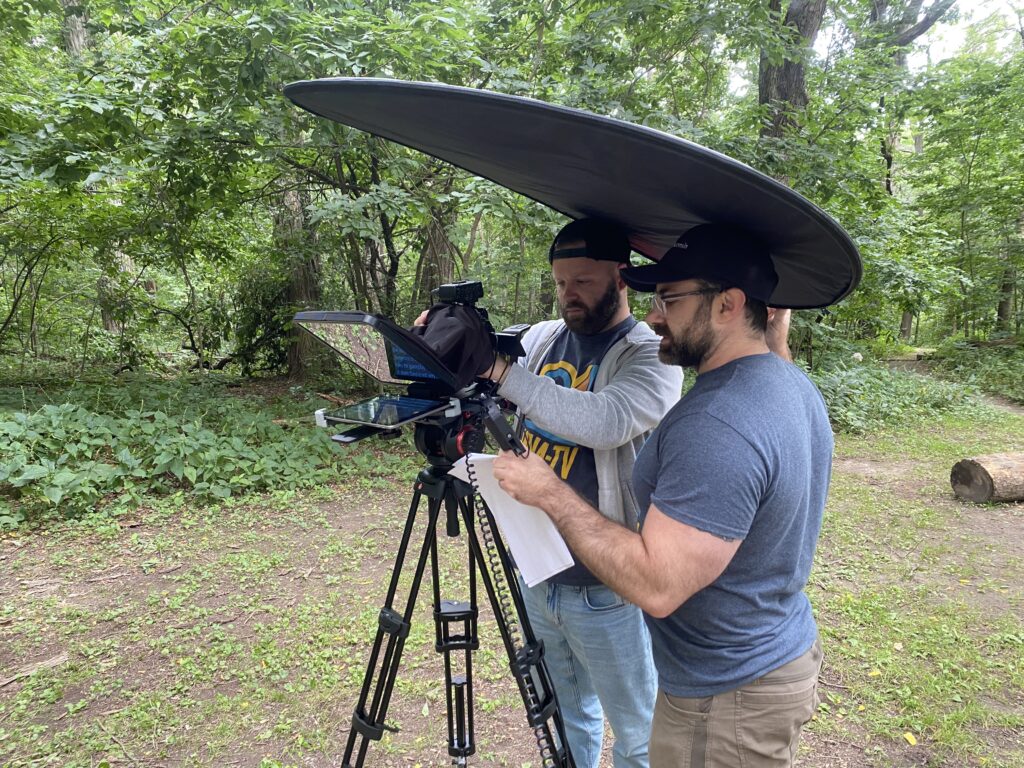
Executive producer Ryan Hendricks (left) and education producer David Boffa set up a shot while filming this summer.
Hoffman: I’m also going to say the D&D episode because as one of the hosts on camera, we don’t really fully know the story and how it plays out yet. I went in kind of knowing where it was going to go based on the script, but that didn’t really give us a full sense. So in real time, I was seeing what the storyline was.
PBS Wisconsin Education: What is it like when you get to see the finished product?
Hoffman: Because it’s just the nature of how we film between in-studio and then on location, I don’t really get a full sense of how the episode’s going to turn out. So, the final episode that comes out sort of looks and feels familiar, but not until you see the fully finished package. You really get a sense of the full vision for the production team and the writers and how it comes through on camera.
Boffa: You know, it’s kind of true for us too, to be honest. You get to the editing and you’re sort of like, how is this going to piece together? And, what do we find in the footage that is going to surprise us and change the edit?
All episodes of The Look Back, along with educator guides, are available on PBS Wisconsin Education’s website. You can also stream all episodes on PBS Wisconsin Education’s YouTube channel and the PBS Wisconsin website. New episodes for season two will continue to be released throughout the school year.
What do you think?
I would love to get your thoughts, suggestions, and questions in the comments below. Thanks for sharing!
Tawny Morrison